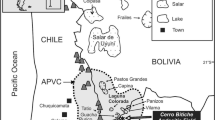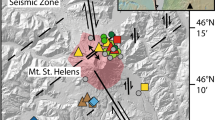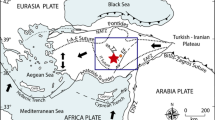Abstract
During a 52-day eruption in 1256 A.D., 0.5 km3 of alkali-olivine basalt was extruded from a 2.25-km-long fissure at the north end of the Harrat Rahat lava field, Saudi Arabia. The eruption produced 6 scoria cones and a lava flow 23 km long that approached the ancient and holy city of Madinah to within 8 km. Three chemical types of basalt are defined by data point clusters on variation diagrams, i.e. the low-K, high-K, and hybrid types. All three erupted simultaneously. Their distribution is delineated in both scoria cones and lava flow units from detailed mapping and a petrochemical study of 135 samples. Six flow units, defined by distinct flow fronts, represent extrusive pulses. The high-K type erupted during all six pulses, the low-K type during the first three, and the hybrid type during the first two.
Three mineral assemblages occur out of equilibrium in all three chemical types.Assemblage 1 contains resorbed olivine and clinopyroxene megacrysts and ultramafic microxenoliths (Fo90 + Cr spinel + Cr endiopside) which fractionated within the spinel zone of the mantle.Assemblage 2 contains resorbed plagioclase megacrysts (An60) with olivine inclusions (Fo78) which fractionated in the crust.Assemblage 3 contains microphenocrysts of plagioclase and olivine in a groundmass of the same minerals with late-crystallizing titansalite and titanomagnetite; assemblage 3 crystallized at the surface and/or in the upper crust. Each assemblage represents a distinct range in PTX environment, suggesting that their coexistence in each chemical type may be a function of magma mixing. Such a process is confirmed by variable ratios of incompatible element pairs in a range of analyses.
All three chemical types are products of mixing. Some of the hybrid types may have developed from surface mixing of the low-K and high-K lavas; however, the occurrence of all three types at the vent system suggests that subsurface mixing was the dominant process. We suggest that the Madinah flow was extruded from a heterogeneous magma chamber containing vertically stacked sections equivalent to the six eruptive pulses. This chamber may have developed contemporaneously with magma mixing when a crustal reservoir containing a magma in equilibrium with assemblage 2 was invaded by a more primitive magma containing cognate microxenoliths and megacrysts of assemblage 1.
Similar content being viewed by others
References
Al-Samhoudy, Nour Al-Deen Ali Bin Ahmed (1954), Wafa Al-Wafa (The story of the Prophet's city, Madinah). Dar Ehia Al-Turath Al-Arabi Publ Co, Beirut, 4:1–1435 (Printed in Arabic)
Baker PE, Brosset R, Gass IG, Neary CR (1973), Jebel al Abyad: a recent alkalic volcanic complex in western Saudi Arabia. Lithos 6:291–314
Barazangi M (1981) Evaluation of seismic risk along the western part of the Arabian plate: discussion and recommendations. Bulletin of the Faculty of Earth Sciences, King Abdulaziz University, Jiddah, Saudi Arabia. 4:77–87
Burton RF Sir (1893) Personal narrative of a pilgrimage to Al Madinah and Maccah. Reprinted 1983 Dover Publications, New York 1–959
Coleman RG, Gregory RT, Brown GF (1983) Cenozoic volcanic rocks of Saudi Arabia. Saudi Arabian Directorate General of Mineral Resources, Open-file report USGS-OF-03-93, 1–82
Deer WA, Howie RA, Zussman J (1978) Rock-forming minerals, 5 Vols, 2nd Ed, Longman Group, London
Einarsson T (1949) The eruption of Hekla, 1947–48, pt.iv, 3: the flowing lava. Soc Sci Islandica
Frey FA, Prinz M (1978) Ultramafic inclusions from San Carlos, Arizona: petrologic and geochemical data bearing on their petrogenesis. Earth Planet Sci Lett 38:129–176
Gass IG, Mallick DJ (1968) Jebel Khariz: an upper Miocene stratovolcano of comenditic affinity on the south Arabian coast. Bull Volcanol 32:33–88
Ghent ED, Coleman RG, Hadley DG (1980) Ultramafic inclusions and host alkali olivine basalts of the southern coastal plain of the Red Sea, Kingdom of Saudi Arabia. Am J Sci 280-A, 499–527
Gregory RT, Coleman RG, Brown GF (1982) Cenozoic volcanic rocks of Saudi Arabia: evidence from the continent for a two-stage opening of the Red Sea. Geol Soc Am annual meeting, Abstracts with Programs. 14, No 7, 502
Hooper PR (1985) A case of simple magma mixing in the Columbia River Basalt Group: the Wilbur Creek, Lapwai, and Asotin flows, Saddle mountains formation. Contrib Mineral Petrol 91:66–73
Hooper PR, Atkins L (1969) The preparation of fused samples in X-ray fluorescence analysis. Mineral Mag 37:409–413
Irvine TN, Baragar WR (1971) A guide to the chemical classification of the common volcanic rocks. Can J Earth Sci 8:523–547
Le Bas MJ (1962) The role of aluminium in igneous clinopyroxene with relation to their parentage. Am J Sci 260:267–288
Macdonald GA (1972) Volcanoes. Prentice-Hall, Englewood Cliffs, New Jersey, 1–510
Miyashiro A (1978) Nature of alkali volcanic rock series. Contrib Mineral Petrol 66:91–104
Mooney WD, Gettings ME, Blank HR, Healy JH (1983) Saudi Arabian seismic deep-refraction profile: a traveltime interpretation of deep crustal structure: Saudi Arabian Deputy Ministry for Mineral Resources Open-file report USGS-OF-03-96, 1–45
O'Hara MJ, Mathews RE (1981) Geochemical evolution in an advancing, periodically replenished, periodically tapped, continuously fractionated magma chamber. J Geol Soc London 138:237–277
Pallister JS (1984) Reconnaissance geology of the Harrat Hutaymah quadrangle sheet 26/42A, Kingdom of Saudi Arabia: Saudi Arabian Directorate General of Mineral Resources Open-file report USGS-OF-04-6, 1–77
Poirier JP, Taher MA (1980) Historical seismicity in the Near and Middle East, North Africa, and Spain from Arabic documents (VIIth–XVIII century). Bull Seismo Soc Am 70, 6:2185–2201
Reidel SP, Fecht KR (1987) The Huntzinger flow: evidence for surface mixing in the Columbia River Basalt Group and petrogenetic implications. Geol Soc Am Bull (in press)
Richard JJ, Van Padang NM (1957) Catalogue of the active volcanoes of the world including solfatara fields, Pt.IV: Africa and the Red Sea. Internat Volcanol Assoc 1–118
Roeder PL, Emslie RF (1970) Olivine-liquid equilibrium. Contrib Mineral Petrol 29:275–281
Simkin T, Siebert L, McClelland L, Bridge D, Newhall C, Letter JH (1981) Volcanoes of the World. Hutchinson Ross, Stroudsburg, Pennsylvania, 1–232
Thorton CP, Tuttle OF (1960) Chemistry of igneous rocks: part I, differentiation index. Am J Sci 258:64–684
Van Padang NM (1963) Catalogue of the active volcanoes of the world including solfatara fields, Part XVI: Arabia and the Indian Ocean. Internat Volcanol Assoc 1–64
Walker GPL, Croasdale R (1972) Characteristics of some basaltic pyroclastics. Bull Volcanol 35:303–317
Walsh JN (1980) The simultaneous determination of major and trace constituents of silicate rocks using inductively coupled plasma spectrometry. Spectrochemica Acta 35B:107–111
Walsh JN, Buckley F, Barker J (1981) The simultaneous determination of the rare earth elements in rocks using inductively coupled plasma source spectrometry. Chem Geol 33:141–153
Wilshire HG, Shervais JW (1975) Al-augite and Cr-diopside ultramafic xenoliths in basaltic rocks from the western United States. Phys Chem Earth 9:257–272
Yoder Jr HS (1976) Generation of basaltic magma. Nat Acad Sci 1–265
Author information
Authors and Affiliations
Rights and permissions
About this article
Cite this article
Camp, V.E., Hooper, P.R., Roobol, M.J. et al. The Madinah eruption, Saudi Arabia: Magma mixing and simultaneous extrusion of three basaltic chemical types. Bull Volcanol 49, 489–508 (1987). https://doi.org/10.1007/BF01245475
Received:
Accepted:
Issue Date:
DOI: https://doi.org/10.1007/BF01245475




